Farmer Entangled in Unguarded Rotating Motor Drive-shaft on Farm-Modified Ear-Corn Elevator
Michigan Case Report: 08MI134
Summary
In the fall of 2008, a 58-yearold male farmer died due to asphyxiation when his clothing became entangled in an ear-corn conveyor rotating motor drive-shaft. The elevator was powered by two hydraulic lines connected to the tractor. The unguarded motor drive-shaft had four bolts, one on each side of the shaft’s connecting hub, that extended at least two inches from the shaft. The decedent’s left sleeve became caught on the bolts as the shaft rotated. The corn elevator and the gravity box he was unloading were empty. His son, who came out to help him, found him lying on the ground with his head resting on the motor and his shirt tightly wrapped around his upper torso and neck. His son ran to the house and called for his mother to come outside. While emergency response was en-route, the decedent’s son found a knife and attempted to cut the decedent’s clothing away from him. Police and emergency response arrived and declared the decedent dead. The police and medical examiner freed the decedent from his entangled clothing (Figure 1).
Recommendations:
- Farmers should inspect all farm equipment to ensure that all exposed rotating or moving parts are guarded/shielded. If guards/shields are missing, appropriate guarding should be installed.
- Farmers should ensure farm-modified equipment is constructed using appropriate parts.
- Farmers should consider adding a shut off/bypass valve on the hydraulic motor for trash removal near the motor unit.
- Machine operators should not wear loose-fitting or frayed clothing. Operators should be aware that jackets and sweatshirts with draw-strings can also be caught in unguarded rotating/moving parts.
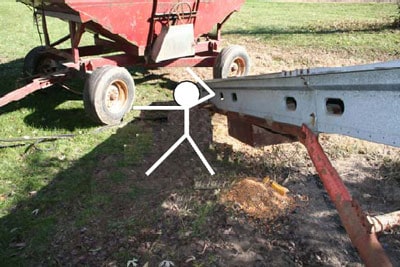
|
|
Figure 1. Position of decedent, laying on his back, head resting on motor facing south, left arm between his ear and the elevator.
|
Introduction
In the fall of 2008, a 58-year-old male farmer died due to asphyxiation when his clothing became entangled in an ear-corn conveyor rotating motor drive-shaft. MFACE was informed of this incident by a MSU County Extension Director. MIFACE would like to thank the MSU County Extension office for their assistance in conducting the initial outreach to the decedent’s family. In July 2009, MIFACE interviewed the decedent’s spouse and son. The family escorted the MIFACE researchers to the incident location, where they were shown the tractor and implement shed in use at the time of the incident. The family no longer had the corn elevator at the farmstead. Pictures used in Figures 1, 3, 4, and 5 are courtesy of the responding sheriff department. Pictures used in Figures 2 and 6 are courtesy of the county extension director, who visited the family several days after the incident.
The decedent had grown up on a dairy farm. He had held a state farmer degree and a Star Farmer award in the late 1960s awarded by the Future Farmers of America (FAA) program. He also was a member of the F AA alumni. During his childhood, he was a 4-H member. He continued his affiliation with 4-H during his adulthood by being a member of the 4-H council, acting as swine superintendent, and promoting the FFA program.
The decedent owned the farmstead for 18 years. He had been raising 4-H feeder pigs. At one time, the farm had 40 pigs, but at the tim e of the incident, 15 sows were being raised. The operation grew corn on 33 acres. It was harvested and stored in an implement shed.
The decedent’s wife indicated that the decedent had not attended any safety meetings hosted by the county extension office.
The decedent had operations performed on each of his knees and had a total knee replacement on his right knee. He was left handed. His wife indicated he also had a “bad” back. He often wore a weight lifting belt to help support his back.
Investigation
The ear-corn elevator was farm-modified, and had previously been owned by another farmer. Two hydraulic hoses, attached to the tractor and the motor, powered the motor. Four bolts, each extending at least two inches from the motor drive-shaft, were unguarded (Figure 2). The motor and its hydraulic connections were located on the east side of the elevator. The hydraulic hoses were haphazardly coiled at the south end of the elevator.
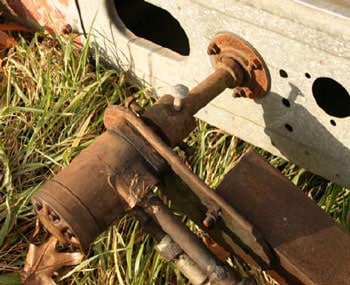
|
|
Figure 2. Motor, drive-shaft with bolts, two hydraulic hoses.
|
The decedent began his chores, including watering and feeding the pigs. The decedent was wearing rubber work boots, jeans, shirt and Carhart® coat. The morning temperature was in the low thirties, and by midday had warmed to 45 degrees Fahrenheit with a southwesterly wind between 5 and 10 mph.
At some point during the day, the decedent positioned the ear-corn elevator in a north/south position to unload the corn onto the floor of the implement shed. The gravity box was positioned against the southern unloading end of the elevator, and the John Deere 560 tractor was positioned to the east of the elevator (Figure 3). The decedent unloaded the ear-corn from the gravity box. He had raised and secured the gravity box unloading bin. Both the elevator and gravity box were empty at the time of the incident.
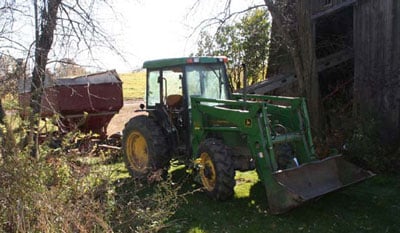
|
|
Figure 3. Positions of implement shed, elevator, gravity box and tractor.
|
In the early afternoon, his son went out to the barnyard to help the decedent. His son found him lying on his back on the ground with his head facing southeast next to the elevator. The tractor was still running. The decedent’s left sleeve of his Carhart® jacket had become entangled on the bolts of the motor drive-shaft. His head was resting on the motor, and his shirt was tightly wrapped around his upper torso and neck. His left arm was positioned above his head, between his head and the elevator (Figures 1 and 4). There was a pile of corn kernels and a couple of corn cobs near the decedent’s left foot. After turning the tractor off, his son ran to the house and called for his mother to come outside. Emergency response was called. While the emergency response personnel were en-route, the decedent’s son attempted to free him using a knife to cut away his clothing. He was unable to do so. When emergency response arrived, the decedent did not appear to be breathing. The responding Fire Department determined that he appeared to have been deceased for some time. When the medical examiner arrived the decedent was declared dead and he was removed from the conveyor.
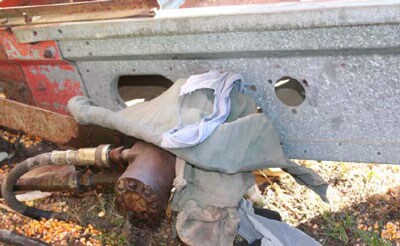 |
|
Figure 4. Decedent’s clothing wrapped around motor shaft.
|
Cause of Death
The cause of death as listed on the death certificate was asphyxiation due to compression of neck. No alcohol or illegal drugs were detected at autopsy.
Recommendations/Discussion
Farmers should inspect all farm equipment to ensure that all exposed rotating or moving parts are guarded/shielded. If guards/shields are missing, appropriate guarding should be installed.
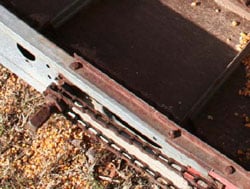
|
|
Figure 5. Unguarded drive chain.
|
Any farm-made guards and shields that are designed and installed are considered a modification of equipment and should meet MIOSHA standards to provide appropriate worker protection. The portable ear-corn elevator had two unguarded entanglement hazards. In addition to the rotating shaft on the southeast side of the corn elevator, the southwest side of the corn elevator had an unguarded moving drive chain (Figure 5). Exposed rotating shafts and moving parts, such as belts, sprockets, and chains present hazardous situations that can cause serious injury or death to workers. Properly designed guards and/or shields should cover any rotating shafts or moving parts that a worker may be exposed to.
There are three areas where mechanical hazards can occur:
Point of Operation: The area on a machine where the employee performs work on the
material, such as cutting, boring, or forming of stock.
Power Transmission Equipment: All mechanical systems that transmit energy to the
part of the machine performing the work. These components include flywheels, pulleys,
belts, connecting rods, couplings, cams, spindles, chains, and gears.
Other Moving Parts: All parts of the machine that move while the machine is working.
Although agricultural operations without hired hands are not required to adhere to MIOSHA general industry or construction health and safety standards, the standards can assist agricultural operations to identify equipment hazards and how to minimize those hazards. MIOSHA General Industry Safety Standard, Part 1, General Provisions, Rule 34 (3) states that “A point of operation guard or device shall be as prescribed in a specific standard, or, in the absence of a specific standard, shall be designed and constructed, when required, to prevent the machine operator exposed to the hazard from having any part of his/her body in the hazardous area during the operating cycle.” Power transmission equipment has a specific MIOSHA standard that identifies guarding requirements: MIOSHA General Industry Safety Standard, Part 7, Guards for Power Equipment. Part 7 requires that parts of equipment that transmit power be safeguarded so that employees do not become entangled, pinched, or caught in moving parts. The guard must be practical, durable and not result in a new hazard, such as burrs or sharp edges.
MIOSHA defines “guarded” as an object is covered, fenced, or surrounded so that it is not exposed to contact (Part 7, Rule 703). Guards should be designed to prevent an individual from being able to reach over, under, around or through the guard into the danger area.
To assist employers to adequately guard power transmission equipment, MIOSHA specifies the requirements in Table A of Part 7, Guards for Power Transmission. Table A is found in Rule 753, Materials, and specifies the material sizes and clearances for guarding power transmission equipment. Table A: Standard Materials and Dimensions for Machinery Guards can be found in Appendix 1 in this report or on page 4 of the MIOSHA standardpdf iconexternal icon: (www.michigan.gov/documents/CIS_WSH_part7_51041_7.pdf).
MIOSHA permits rotating or moving parts that require frequent oiling to be guarded with hinged or sliding self-closing covers. (Part 7, Rule 732. Openings for oiling).
- Farmers should ensure farm modified equipment is constructed using appropriate parts.
Again the MIOSHA rules provide useful guidance. Part 7, Rule 736 states that projecting keys, set screws and other projections in revolving parts exposed to contact, shall be removed, made flush or guarded.
Although if adequately guarded, the excessive bolt length (Figure 6) would not have been a factor, farmers should inspect farm equipment, especially if farm-modified, to ensure that the best possible part selection was used and that a safety hazard was not created. In this incident, machine set screws could have been used instead of bolts and shield/guards installed.
- Farmers should consider adding a shut off/bypass valve on the hydraulic motor for trash removal near the motor unit.
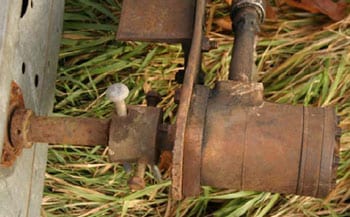
|
|
Figure 6. Bolts on motor drive-shaft.
|
The decedent’s activity at the moment his clothing became entangled on the unguarded rotating shaft bolts was unknown. It was postulated that as he was finished with unloading the gravity box and had secured the unloading door in place, he may have been cleaning the corn elevator at the box unloading area or the elevator unloading area (see Figure 1 for a pile of corn near the decedent’s foot). If a bypass/shut off valve had been present, the decedent could have easily shut off power to the elevator, thus eliminating the entanglement hazards posed by the unguarded rotating shaft and chain.
- Machine operators should not wear loose-fitting or frayed clothing. Operators should be aware that jackets and sweatshirts with draw-strings can also be caught in unguarded rotating/moving parts.
Guarding and the use of appropriate parts is the primary approach to preventing entanglement in rotating shafts and machine components. When such systems fail, the risk of entanglement can be reduced if operators do not wear loose-fitting clothing. Work clothing should be well-fitting and zippered or buttoned, not open. Frayed or loose fitting clothes, jackets and sweatshirts with drawstrings, and boots or shoes with long shoelaces should be avoided. Long hair should be tied back or under a cap. Additionally, watches, rings or other jewelry should not be worn when working around mechanical equipment.
References
MIOSHA standardsexternal icon cited in this report may be found at and downloaded from the MIOSHA, Michigan Department of Energy, Labor & Economic Growth (DELEG) website at: www.michigan.gov/mioshastandards. MIOSHA standards are available for a fee by writing to: Michigan Department of Energy, Labor & Economic Growth, MIOSHA Standards Section, P.O. Box 30643, Lansing, Michigan 48909-8143 or calling (517) 322-1845.
- Farm and Ranch Safety Management, 4th Edition, Copyright 1994, Deere & Company, Moline, Illinois.
- Portable Auger Safety Manual. Farm and Industrial Equipment Institute (FIEI). 410 N. Michigan Ave., Chicago, IL. 60611, 1985. (Name change to Equipment Manufacturer’s Institute in 1989).
- MIOSHA General Industry Safety Standard, Part 1, General Provisions.
- MIOSHA General Industry Safety Standard, Part 7, Guards for Power Transmission.
- MIOSHA Standard Interpretations for General Industry, Machine Guardingexternal icon.
http://www.michigan.gov/lara/0,4601,7-154-61256_11407_15349-151963–,00.html (Link Updated 4/1/2013)
Key Words: Portable Ear-corn Elevator, Entanglement, Guarding, Agriculture
Appendix 1
|
Material
|
Clearance Moving Part at all Points (Inches) | Largest Mesh or Opening Allowable B (Inches) | Minimum Gauge (U.S. Standard) or Thickness |
|---|---|---|---|
|
Woven Wire
|
Under 2 2 – 4 4 – 15 |
3/8 1/2 2 |
No. 16-3/4 In. No. 16-1/2 No. 12-2 |
|
Expanded Metal
|
Under 4 4 – 15 |
1/2 2 | No. 18-1/2 In. No. 13-2 |
|
Perforated Metal
|
Under 4 4 – 15 |
1/2 2 | No. 20-1/2 In. No. 14-2 |
|
Sheet Metal
|
Under 4 4 – 15 |
— | No. 22 No. 22 |
|
Wood or Metal Strips Crossed
|
Under 4 4 – 15 |
3/8 2 | 3/4 In. Wood or No. 16 Metal |
|
Wood or Metal Strips Not Crossed
|
Under 4 4 – 15 |
1/2 the width One Width |
|
|
Plywood, Plastic, or Equivalent
|
Under 4 4 – 15 |
— | 1/4 In. 1/4 In. |
|
Standard Railing
|
Min.15 Max. 20 |
— | — |
Michigan FACE Program
MIFACE (Michigan Fatality Assessment and Control Evaluation), Michigan State University (MSU) Occupational & Environmental Medicineexternal icon, 117 West Fee Hall, East Lansing, Michigan 48824-1315; http://www.oem.msu.edu. This information is for educational purposes only. This MIFACE report becomes public property upon publication and may be printed verbatim with credit to MSU. Reprinting cannot be used to endorse or advertise a commercial product or company. All rights reserved. MSU is an affirmative-action, equal opportunity institution. 10/20/09
Link updated 05/25/2010
MIFACE Investigation Report # 08MI134 Evaluationpdf iconexternal icon (see page 9 of report)
External link: http://www.oem.msu.edu/MiFace/08MI134.pdf#page=9
| |
_
